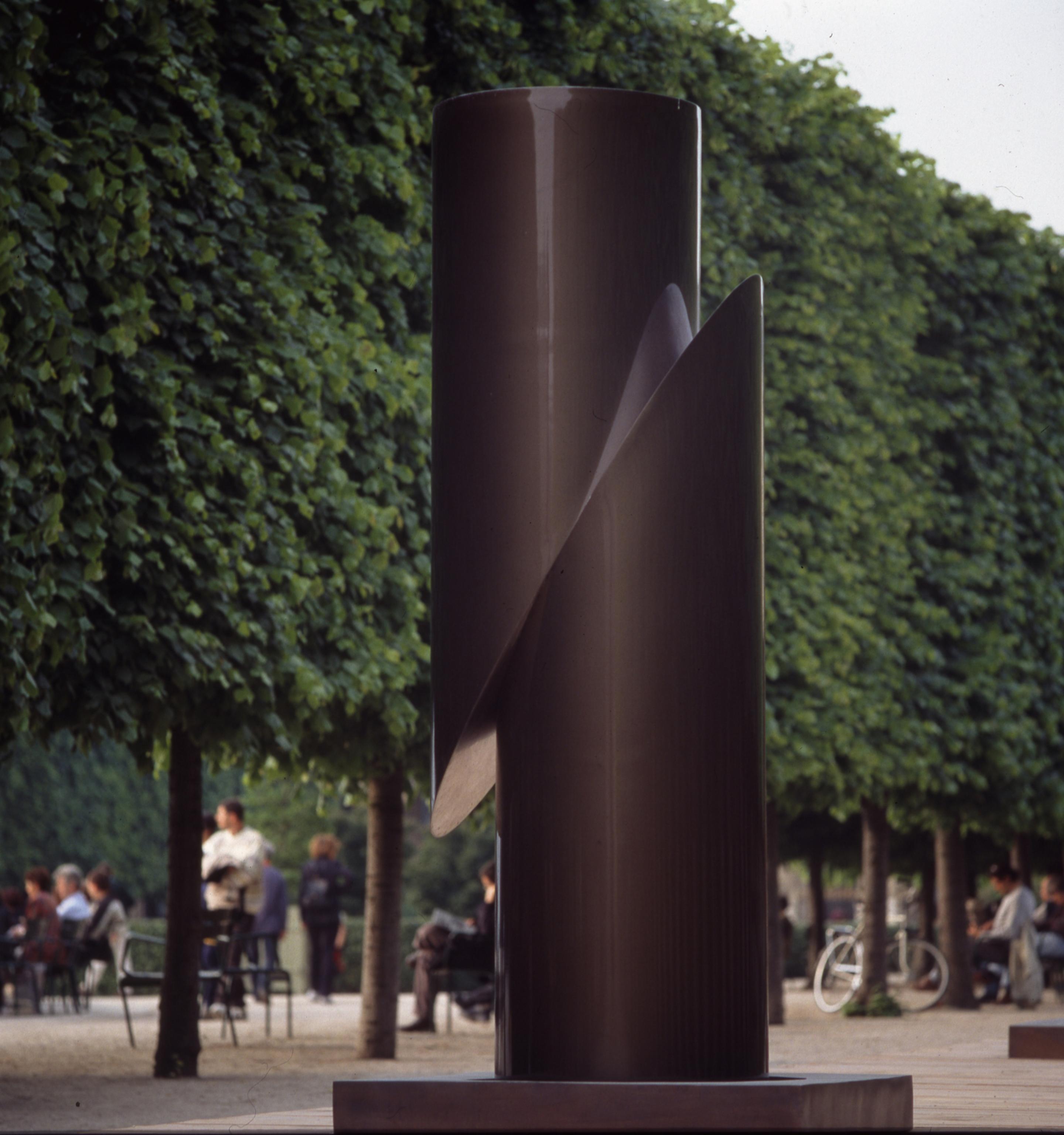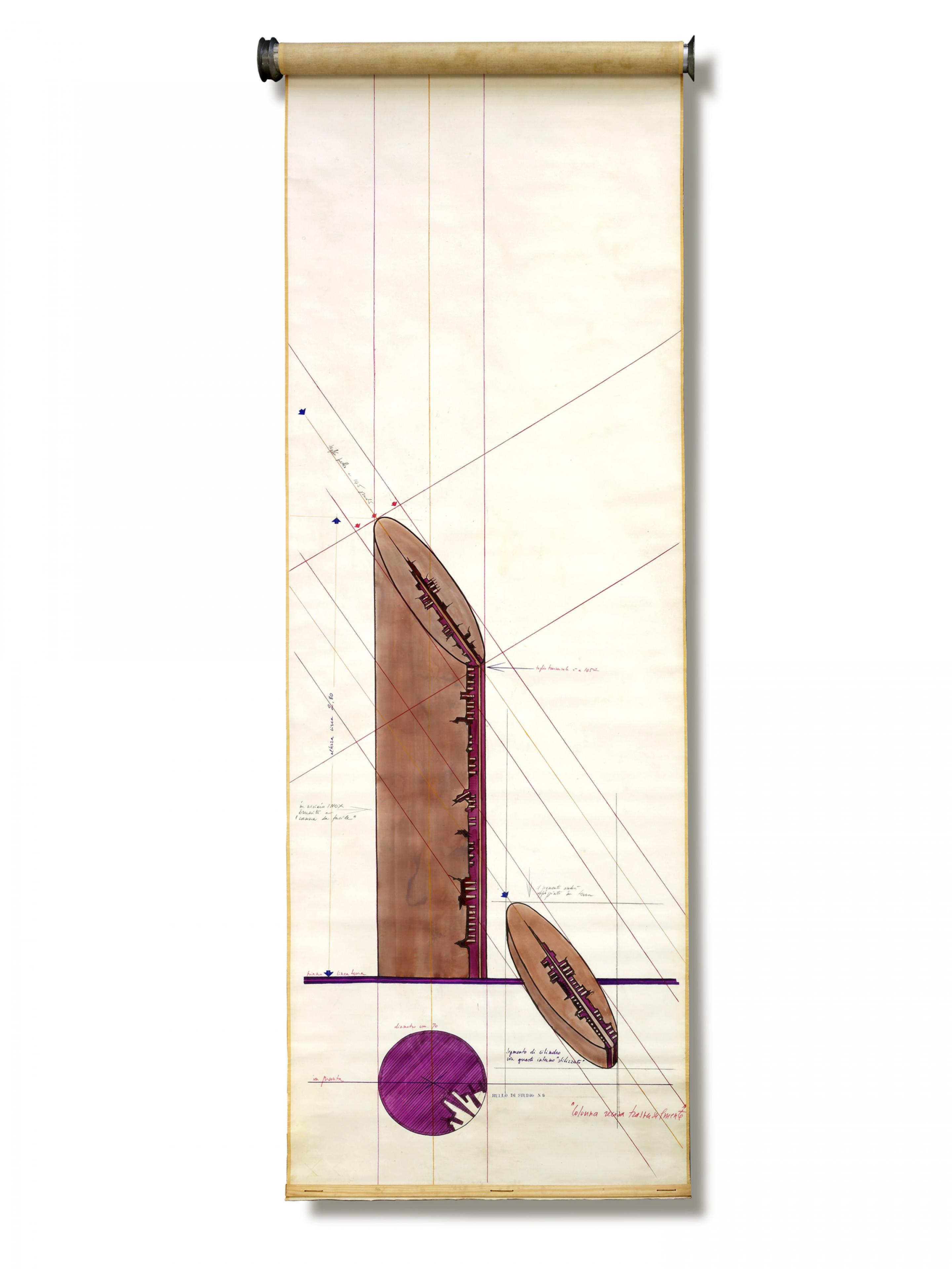ArnaldoPOMODORO
Arnaldo Pomodoro. A Hundredth of a Second
12.2016–02.2017
Arnaldo Pomodoro. A Hundredth of a Second
12.2016–02.2017
ArnaldoPOMODORO
Press Release
Arnaldo Pomodoro
A Hundredth of a Second
Opening: December 1, 2016
December 2 – February 4, 2017
A Hundredth of a Second
Opening: December 1, 2016
December 2 – February 4, 2017
On the occasion of the major retrospective celebrating Arnaldo Pomodoro’s ninetieth birthday, sponsored by City of Milan-Culture and curated by Ada Masoero in collaboration with the Arnaldo Pomodoro Foundation, the Marconi Foundation will pay tribute to this influential Twentieth-century figure with a rerun of the exhibition A Hundredth of a Second.
The exhibition, with its focus on Pomodoro’s research into the movement of sculptural masses, was originally held at Studio Marconi in 1971 and includes a selection of works created between 1966 and 1971 (large drawings, studies, sculptures in steel and fibreglass).
“Arnaldo Pomodoro’s most insistent metaphor has been to break the shell or skin of things in order to reach a fragile and vulnerable marrow”, wrote Sam Hunter in 1974, fully grasping the essence of the artistic quest Pomodoro commenced in the Sixties.
Indeed, “to discover what is in a form, which on the surface seems so perfect and absolute” was Pomodoro’s mission statement to the US critic in an interview that same year.
The entire essence of Arnaldo Pomodoro’s art lies in the image of a perfect and coherent form that has been split open; it is his personal metaphor in the dialogue between external and internal and is almost always present in his works; it is a dialectic that holds multiple meanings.
By destroying traditional forms, Arnaldo Pomodoro expresses a freedom from any restrictions; bringing the energy of matter to the surface means stripping the geometric shape of its physical immobility and challenging ideological stability, thus proposing a new type of monument.
Finally, freeing sculpture from gravitational weightiness means it can acquire its own dynamic and be transformed into “sculpture in motion”.
The exhibition, with its focus on Pomodoro’s research into the movement of sculptural masses, was originally held at Studio Marconi in 1971 and includes a selection of works created between 1966 and 1971 (large drawings, studies, sculptures in steel and fibreglass).
“Arnaldo Pomodoro’s most insistent metaphor has been to break the shell or skin of things in order to reach a fragile and vulnerable marrow”, wrote Sam Hunter in 1974, fully grasping the essence of the artistic quest Pomodoro commenced in the Sixties.
Indeed, “to discover what is in a form, which on the surface seems so perfect and absolute” was Pomodoro’s mission statement to the US critic in an interview that same year.
The entire essence of Arnaldo Pomodoro’s art lies in the image of a perfect and coherent form that has been split open; it is his personal metaphor in the dialogue between external and internal and is almost always present in his works; it is a dialectic that holds multiple meanings.
By destroying traditional forms, Arnaldo Pomodoro expresses a freedom from any restrictions; bringing the energy of matter to the surface means stripping the geometric shape of its physical immobility and challenging ideological stability, thus proposing a new type of monument.
Finally, freeing sculpture from gravitational weightiness means it can acquire its own dynamic and be transformed into “sculpture in motion”.
“The erosions and explosions in his forms have never already happened or been concluded but are seen at the moment of their inexorable becoming. Pomodoro’s sculpture is always an ongoing process.” (D. Porzio, 1976)
And it is movement that Pomodoro refers to in the catalogue accompanying the 1971 exhibition when he says: “Today I feel a huge and majestic movement of collapse.”
In the short text in which he speaks of his art, he claims to have reached the highest awareness of his mental processes regarding spheroids and cylinders, and to be now ready to give precedence to the significance of the movement of sculptural masses, adding that this is not a semantic or literary meaning but a kind of ironic and original vision capable of emphasising the imbalance between nature and vision, and between established order and unpredictable invention.
Herein lies the huge and majestic “movement of collapse” that emanates from the precarious severed columns depicted in large drawings, or executed in shiny reflective bronze.
On the one hand, breaking the forms allows the artist to discover their “mysterious and pure” internal foment, and so respond to an otherwise unsatisfied need to discover.
On the other, the mirror-like surface of the works allows all that surrounds the sculpture to be perceived, so that it becomes an integral part.
“I think the reflections of light are very important. During the day, in sunlight or shade, the sculptures truly change. The mirror-like effects include what is all around you, the viewer… This makes the sculpture alive, a part of us, of nature, in whatever place it is.” (A. Pomodoro, 1974)
Marco Valsecchi described the works on display in an article in the "Giorno" newspaper on 17 June 1971, some days after the exhibition opening: “… columns corroded and then split lengthwise, as though struck by lightning, divided into two to reveal their recesses and internal joints. Another is cut horizontally into two pieces and about to collapse, with half the column already off balance.” He continues: “Standing in front of this column cleanly cut in half, you feel the shock of its imminent collapse: the top is about to slip to the ground and break into fragments with a great roar; we catch it at that extreme moment – at exactly that a hundredth of a second – before its path to ruin. Which, in fact, will not happen.”
At a distance of forty-five years that very same “movement of collapse”, caught for a hundredth of a second in the “monumentally immobile” volume of sculptural mass, is still present before us. A poetic invention that is still alive, surprising and exciting, one that subverts all established order and, against all the laws of statics, allows us to feel the suspension of the moment, a becoming that will never take place.
And it is movement that Pomodoro refers to in the catalogue accompanying the 1971 exhibition when he says: “Today I feel a huge and majestic movement of collapse.”
In the short text in which he speaks of his art, he claims to have reached the highest awareness of his mental processes regarding spheroids and cylinders, and to be now ready to give precedence to the significance of the movement of sculptural masses, adding that this is not a semantic or literary meaning but a kind of ironic and original vision capable of emphasising the imbalance between nature and vision, and between established order and unpredictable invention.
Herein lies the huge and majestic “movement of collapse” that emanates from the precarious severed columns depicted in large drawings, or executed in shiny reflective bronze.
On the one hand, breaking the forms allows the artist to discover their “mysterious and pure” internal foment, and so respond to an otherwise unsatisfied need to discover.
On the other, the mirror-like surface of the works allows all that surrounds the sculpture to be perceived, so that it becomes an integral part.
“I think the reflections of light are very important. During the day, in sunlight or shade, the sculptures truly change. The mirror-like effects include what is all around you, the viewer… This makes the sculpture alive, a part of us, of nature, in whatever place it is.” (A. Pomodoro, 1974)
Marco Valsecchi described the works on display in an article in the "Giorno" newspaper on 17 June 1971, some days after the exhibition opening: “… columns corroded and then split lengthwise, as though struck by lightning, divided into two to reveal their recesses and internal joints. Another is cut horizontally into two pieces and about to collapse, with half the column already off balance.” He continues: “Standing in front of this column cleanly cut in half, you feel the shock of its imminent collapse: the top is about to slip to the ground and break into fragments with a great roar; we catch it at that extreme moment – at exactly that a hundredth of a second – before its path to ruin. Which, in fact, will not happen.”
At a distance of forty-five years that very same “movement of collapse”, caught for a hundredth of a second in the “monumentally immobile” volume of sculptural mass, is still present before us. A poetic invention that is still alive, surprising and exciting, one that subverts all established order and, against all the laws of statics, allows us to feel the suspension of the moment, a becoming that will never take place.










